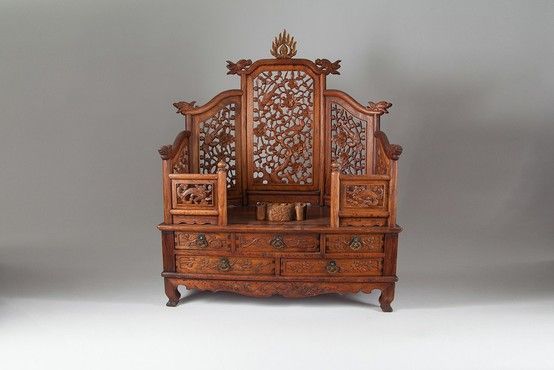![64524]()
A Chinese Order of the Double Dragon. © Maynards
VANCOUVER.- Maynards will be hosting an International & Asian Art Auction on March 12 – 13.
The auction will offer a unique range of jades, ceramics, other antiques and fine arts. Combined, the collections are valued from $1 to $1.5 million. Maynards is hoping to surpass last year’s outstanding jade auction which resulted in a several pieces going for $1.3 million.
This year, Maynards is proud to feature pieces from the collection of the late philanthropist and prominent Iranian business man, Mr. Habib Sabet. Several of Mr. Sabet’s pieces will be up for auction on Wednesday March 13th from 9:20 p.m. onwards. They include:
· Lot 584 & 587; Two Chinese jade vases of very pale celadon colour, valued $40,000 to $60,000
![5ddfd8b1a71ce32d91cefbc2d317f539]()
A Chinese jade vase and cover of very pale celadon colour. © Maynards
the flattened baluster form body carved in the manner of archaistic bronze with opposing phoenix and a loose ring and mask handle and having four loose ring and dragon head handles below the neck, the cover with four mythical beasts seated below a floral finial, Qianlong (1730-1795). Height: 16 1/2 in. (42 cm) (comes with carved and gilt wood stand). Condition: Good, drilled at base and cover as a lamp - Estimate $ 40,000-60,000
Provenance: Purchased from Christies London, June 21st 1971. From the Collection of the late Habib Sabet, and thence by familial descent to the current owner.
![64205]()
A Chinese pale celadon jade vase and cover. © Maynards
carved in relief in the manner of archaic bronze form with Toatie masks and a pair of loose ring handles, the cover with a pair of phoenix and a flower finial, Qianlong (1736-1795) height: 13 in. (33 cm) (comes with carved wood stand). Condition: Converted as a lamp, drilled - Estimate $ 40,000-60,000
Provenance: From the Collection of the late Habib Sabet, and thence by familial descent to the current owner.
· Lot 585; Chinese light celadon jade incense burner and cover, valued $40,000 to $60,000 · Lot 585; Chinese light celadon jade incense burner and cover, valued $40,000 to $60,000
![64203]()
A Chinese light celadon jade incense burner and cover. © Maynards
The base with carved peony handles with loose rings and six mythical beast masks with loose rings, the three leg with carved beast masks; the cover with three lion dogs and loose rings, Qianlong (1736-1975) height: 7 1/2 in. (19 cm) (comes with carved and gilt wood stand). Condition: Converted as a lamp, drilled - Estimate $ 40,000-60,000
· Lot 586; A Chinese spinach green jade potpourri holder, valued $40,000 to $60,000
![64204]()
A Chinese spinach green jade potpourri (Lu) and pierced cover. © Maynards
the base with floral designs in relief and having a pair of dragon handles with loose rings; the domed cover pierced with floral traceries below a lotus blossom finial, Qianlong (1736-1795)height: 6 1/2 in. (16.5 cm) (comes with carved and gilt wood stand). Condition: Converted as a lamp, drilled - Estimate $ 40,000-60,000
Provenance: Purchased from Christies London, June 21st 1971. From the Collection of the late Habib Sabet, and thence by familial descent to the current owner.
· Lot 588; A Chinese imperial jade table screen, valued $40,000 to $60,000
![64200]()
A Chinese imperial jade table screen and gilt cloisonne stand. © Maynards
the very light celadon coloured screen carved in relief with a crab amongst lotus and millet stems below a pierced stylized dragon top, Qianlong (1735-1795) The screen: 10 in. h. x 7 1/4 in. w. (25.5 x 18 cm). Condition: A 3 inch crack at top, 3/4 inch crack to side. Estimate $ 40,000-60,000
Provenance: Purchased from Christies London, June 21st 1971 by the Sabet family. From the Collection of the late Habib Sabet, and thence by familial descent to the current owner.
· Lot 589; A finely crafted Chinese mutton fat green jade potpourri holder, valued $80,000 to $120,000
![64201]()
A Chinese mutton fat jade potpourri (Lu) and cover. © Maynards
the bowl and cover pierced with scrolling flowers and phoenix having two carved floral handles below a coiled dragon finial and raised upon three stub feet, Qianlong (1736-1795)height: 5 1/2 in. (14 cm). Condition: Good, some natural fissures to base - Estimate $ 80,000-120,000
Provenance: Purchased from Christies London, July 1963, Lot 3, by the Sabet family. From the Collection of the late Habib Sabet, and thence by familial descent to the current owner.
“We are delighted to offer a diverse array of international art pieces” says Hugh Bulmer, Vice President and specialist in Asian ceramics, “Mr. Sabet was an astute collector of Chinese jade antiques and his pieces showcase fine jade of the period.”
The Sabet family antique collection includes pieces with exquisite craftsmanship from both the eighteenth century French decorative arts and Chinese jades. Habib Sabet was a successful businessman who founded more than 40 corporations and introduced the first television network in Iran, collected these pieces throughout the duration of this life. He spent his last years based in Paris, France tending to his extensive collection. Though many pieces in the collection remain in the Sabet family, many of the rarer and unique pieces now reside in some of the world’s most prestigious museums including the Louvre and Getty Museum.
Habib Sabet was a highly prominent 20th century Iranian businessman, who achieved great corporate success in countless commercial and industrial ventures in banking, construction, pharmaceuticals, energy and more. Habib and his son can be credited with the introduction of the first television network in Iran. Habib Sabet was a noted philanthropist and collector of art and antiques. His passion for antiques included, but was not limited to, the exquisite craftsmanship of eighteenth century French decorative arts and Chinese jades. In a chapter concerning Habib Sabet in Eminent Persians: The Men and Women Who Made Modern Iran, 1941-1979, the author makes note that for Mr. Sabet, "one indulgence was collecting antiques and jade," and that, "he spent his last years travelling, and tending to his vast collection of antiques and works of art." Some of the Sabet treasures have now made their way into the great museums of the world, such as the Louvre and the Getty Museum. Mention of French furniture belonging to Habib Sabet, now in the Getty Museum, can be found in Hess, Catharine and Gillian Wilson. A Summary Catalogue of European Decorative Arts in the J. Paul Getty. Los Angeles, California: The J. Paul Getty Museum, pgs 29 & 42.
In addition to the Sabet family’s collection, Maynards’ auction also includes an “Order of the Double Dragon” medal awarded to a Scottish missionary, Dr. Dugald Christie, by the Emperor of China. Dr. Christie was awarded the medal for his work in dealing with the 1912 Plague in China. Dr. Christie’s medical service to China has been documented in several books including the Thirty Years in Moukden 1883-1913.
![64524_view_03_02]()
A Chinese Order of the Double Dragon. © Maynards
First Class, Third Grade, in gold, the front decorated with double dragons inside a kingfisher feather border, the reverse inscribed with Chinese characters, presented to Dr. Dugald Christie, Esq. C.M.G., Medical Officer by the Emperor of China for his work in the Prevention of the Plague, Mukden Station. 2 1/2 x 1 3/4 in. (6.35 x 4.45 cm). Estimate $ 70,000-90,000
Provenance: Dr. Christie, (1855-1936), was a Scottish medical missionary who studied medicine at the Edinburgh Medical Missionary Society. In 1882 he began work as a medical missionary in Manchuria and by 1883 had opened a small hospital which served the residents during outbreaks of war and epidemics. In this small hospital he began training students in the ways of western medicine. By 1912 he had established the Mukden Medical College which went on to produce hundreds of medical graduates each year. For his many years of dedicated service to the people of China he was the recipient of many awards including: Russian Red Cross Decoration in 1905:, Chinese Red Cross Decoration in 1908: Chinese Order of the Precious Star in 1911; Chia Ho in 1922; and this Order of the Double Dragon for his work in dealing with the Plague in 1912.
Also a writer he published several books including Thirty Years in Moukden 1883-1913.
![64524_view_04_03]()
Dr. Dugald Christie, Esq. C.M.G., Medical Officer © Maynards




























































